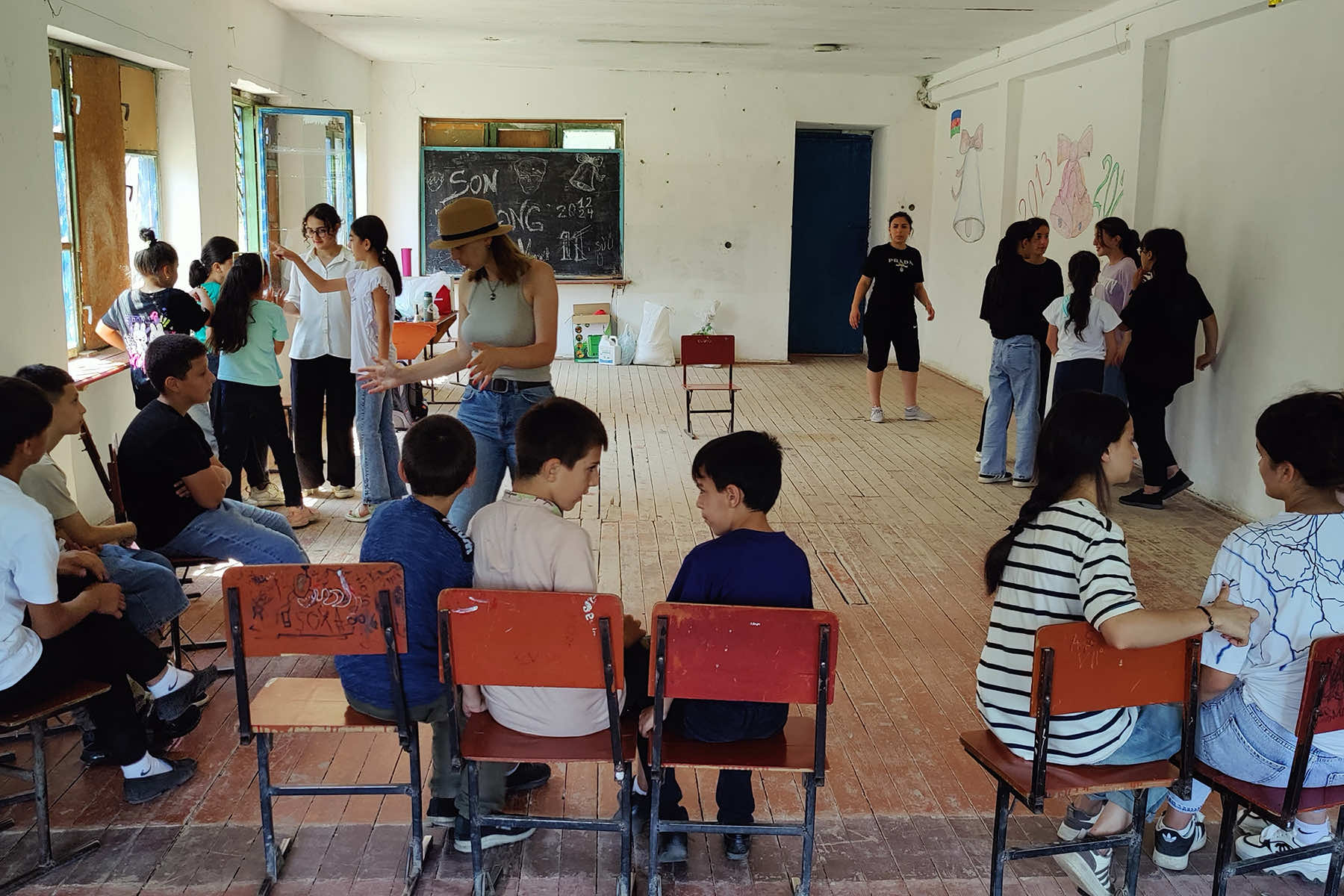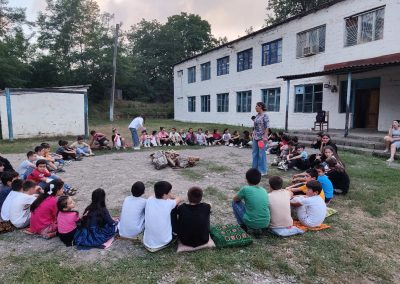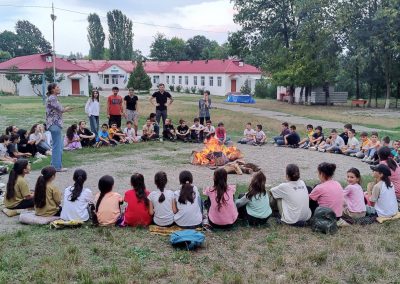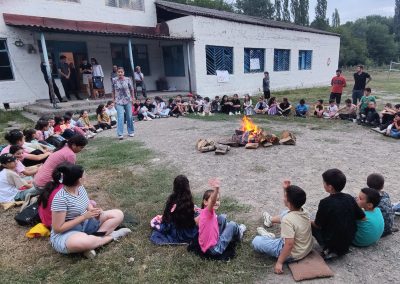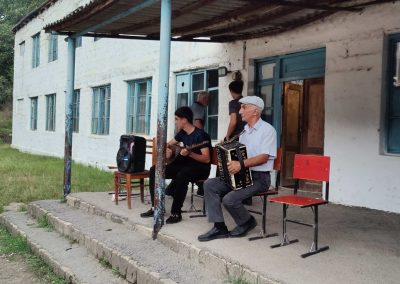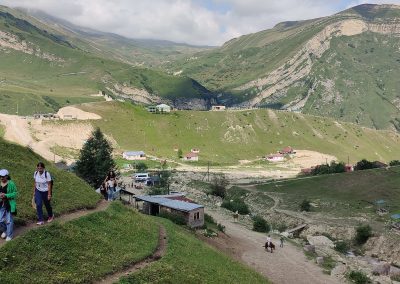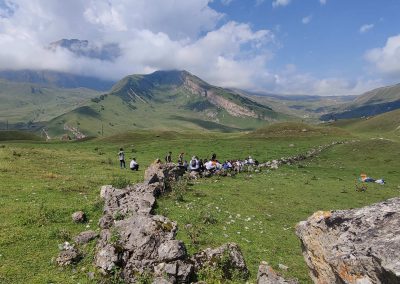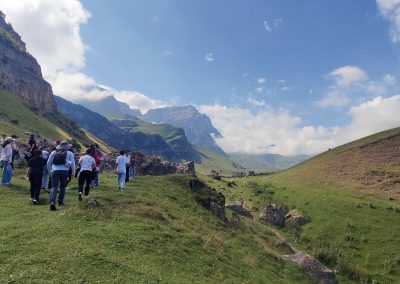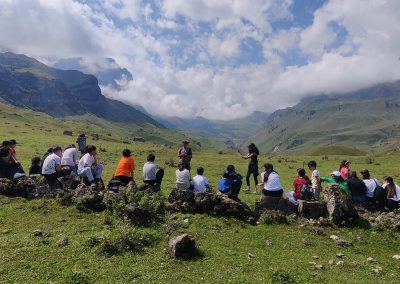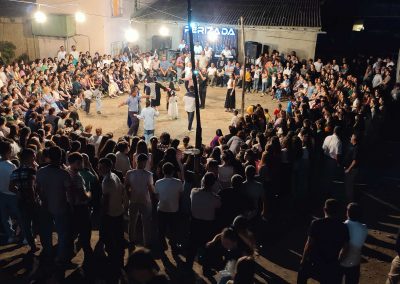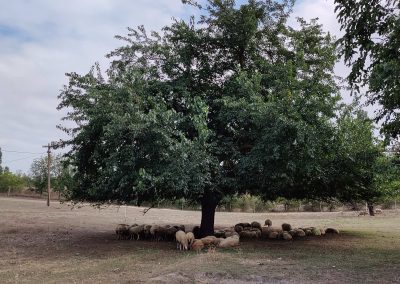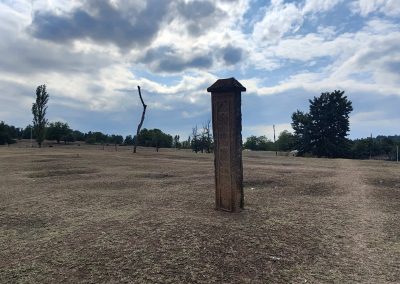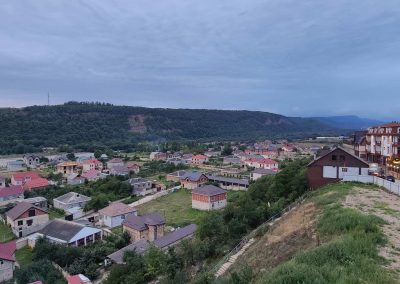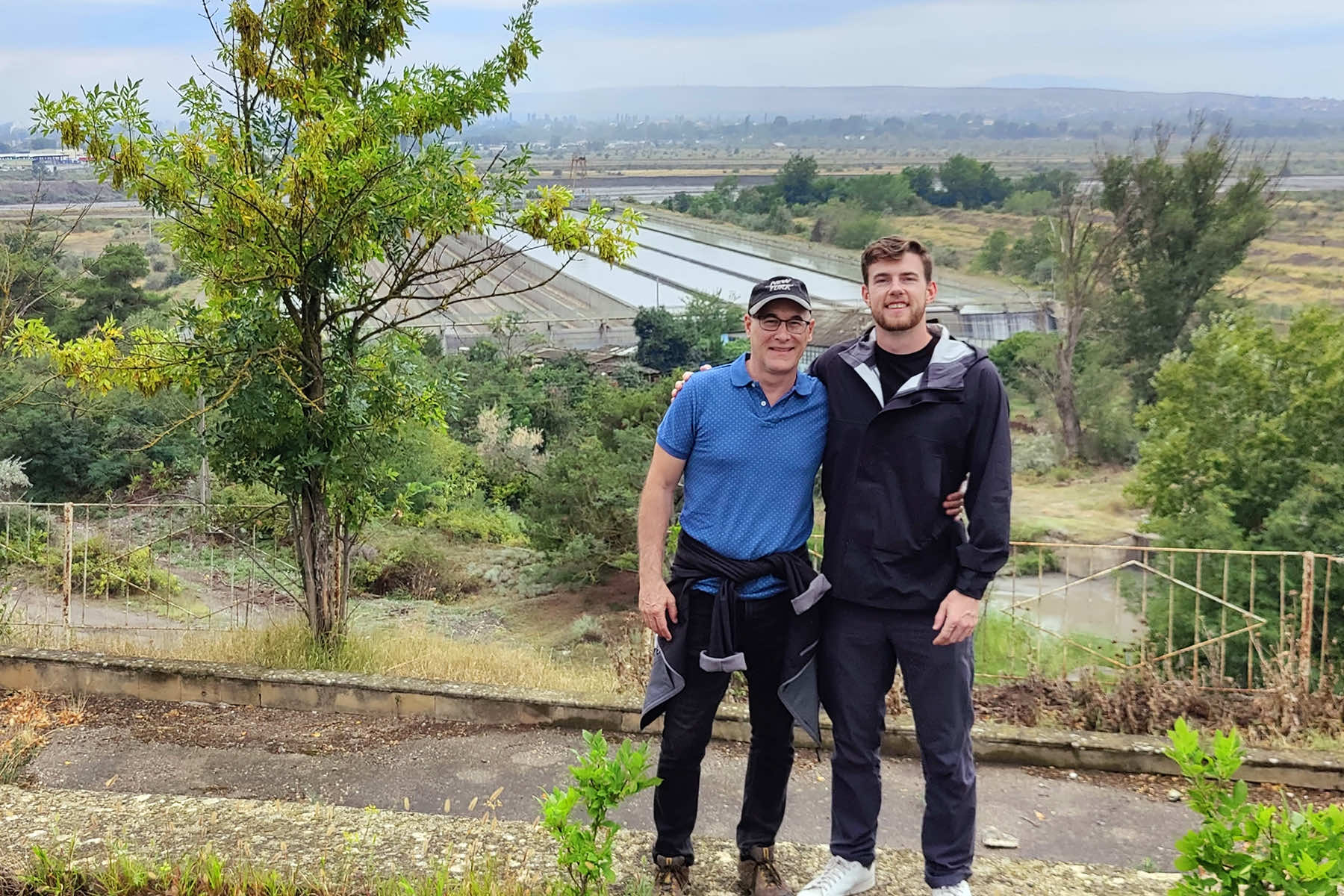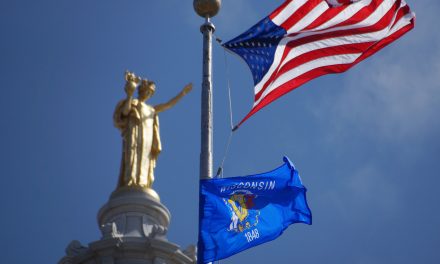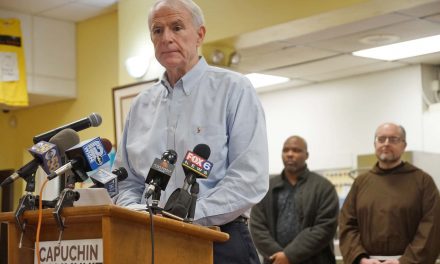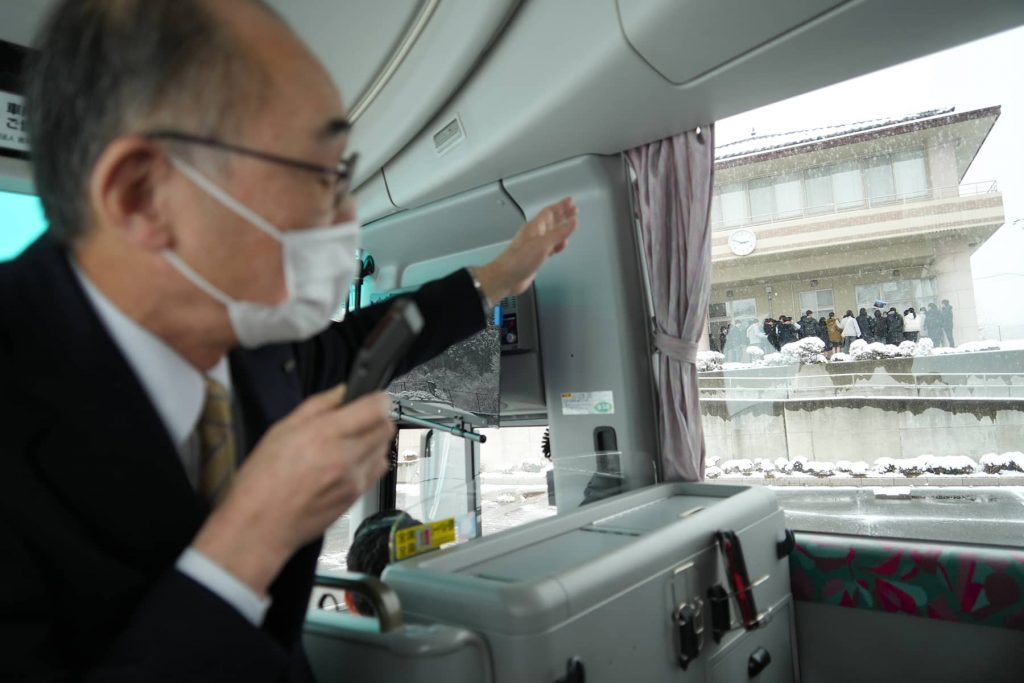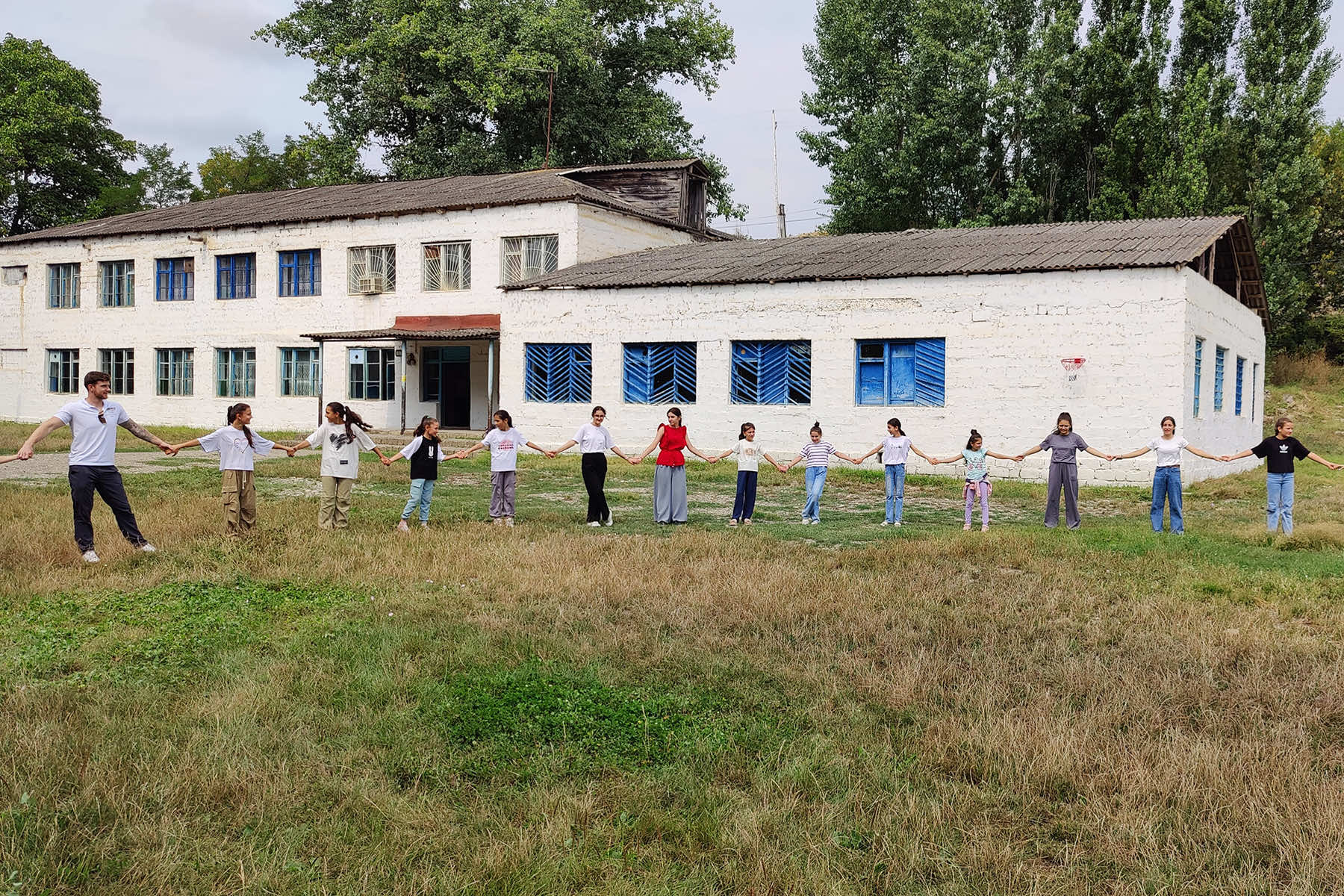
Edward Morgan found inspiration in an unexpected meeting with Matt Schultz to create a free summer youth camp in the Qusar District of Azerbaijan. The two embarked on a plan to make a difference in the lives of those local children, blending their talents and experiences to foster a meaningful cultural exchange.
In February, I met Matt Schultz, a young man from Chicago with an interesting plan. Matt studied in Azerbaijan a few years ago and while he was there, he took a trip with Camping Azerbaijan, the country’s first eco-tourism company. They hiked in the mountains near Qusar and stayed with locals.
It made a deep impression on Matt and eventually inspired his plan to team up with Camping Azerbaijan and apply for a grant to fund a free summer camp for kids in the Qusar District. That sounded like a great idea to me, as I have helped run summer camps over the years. So, that was how I got involved.
In May, we were awarded a State Department grant called CDAF (Citizen Diplomacy Action Fund) and it was just enough support to make the plan work. By then we had located a village in Qusar with a school we could use for our camp. We had also assembled a strong team of counselors.
From Camping Azerbaijan there was Gunay, who works for the Transcaucasian Trail Association, and Tural, who had been the guide on Matt’s first Qusar hiking trip but now works in Stockholm. Zahra is an engineer and influencer from Baku, and Sugra was the history teacher at the village school.
We also had two university students as assistant counselors, Sara and Sevinc. Thankfully, they all spoke English well enough to translate for Matt and me, since neither of us know much Azerbaijani.
In late July, I flew to Baku and spent a week there getting to know the city. Then Matt arrived and we finally all met face-to-face in a restaurant near the Old City over a steaming plate of plov. Everyone was ready for an adventure. A few mornings later, Gunay arranged for a taxi-van to take us to Qusar.
North of Baku the terrain is dry and mostly flat until you reach an oddly-shaped mountain called Besh Barmag (Five-Finger Mountain). It is famous for pilgrimages, making wishes, and birdwatching. At the foot of the mountain there is a mosque. Further up there is a place where pilgrims get a personal blessing, for a small donation.
There are trees along the trail near the top where people tie colorful strips of cloth as prayers or wishes. From the summit you can look out over the Caspian Sea and, especially in autumn or late spring, you can see hundreds of species of migrating birds because the corridor between the mountains and the sea acts as a bottleneck.
We stopped for coffee at a little row of shops across the highway from Besh Barmag. Sadly, there was not time to hike to the top, so I made a wish from there. Our destination was Imamgulukend, a village nestled in the hills near the Russian border.
The people there are Lezgi (or Lezgin), an ethnic and linguistic minority indigenous to northern Azerbaijan and Dagestan, across the border. There are about 200,000 Lezgi in Azerbaijan and at least 400,000 in Russia. But since both countries have assimilationist policies the census numbers cannot be fully trusted. Some Lezgi also apparently claim to be ethnically Azerbaijani to avoid discrimination.
The Lezgi have lived in the South Caucasus for centuries. Their ancestors fought with the Persians against Alexander the Great. They fought the Russian Empire for decades. Their first language is Lezgi, their second is Azerbaijani, and most older adults speak some Russian. They are Sunni Muslim but not particularly religious.
There was no Imam in the village, despite the name Imamgulukend, nor even a mosque. I do not recall any women there wearing a hijab. I was told that Lezgi are individualistic, egalitarian, proud, and clannish, which made them sound like folks from a small town in Wisconsin. I was also told that if we had all been outsiders, some locals might not trust us with their children. But Sugra is a much-beloved teacher and Gunay is Lezgi – she grew up in a village not far away. So we were accepted without question.
It was mid-afternoon when we got to Imamgulukend. Our Baku driver was arguing with Gunay. I later learned that he was angry because he had not known there would be Americans on the trip or he would have charged us more. But Gunay held firm. We pulled up to the farmhouse where we were going to stay and unloaded our bags. She paid him and he drove off with a scowl.
It was a big farmhouse about a kilometer from the school. The widow who lives there was glad to rent us the place for 10 days. We slept two or three to a room and some of us had to sleep on the floor but we all had a mattress. There was plenty of hot water but just one shower and instead of a toilet there was an outhouse in the yard.
So it was not a luxury hotel but not quite camping either. The best thing about our lodging was Sugra’s cousin, Tunzala, who came from Baku to shop and cook for us. Azerbaijani food is delicious, with influences from Turkish, Russian, and Persian cuisine. Having Tunzala there was like living with a gourmet chef.
Imamgulukend is a sprawling agricultural village with a population of 2,700. It has a few small grocery stores and one main paved road leading south to the district capital, Qusar, with a population of 21,300. The country’s median age is 33, but the majority of adults we saw were older, perhaps because many of the younger adults work in Baku or are living in Russia or Türkiye as guest workers.
This condition is true in many villages. The official unemployment numbers are low but there is hidden unemployment and underemployment. In 2023 the national average monthly salary was around $400, though in Baku of course, in the oil business especially, wages are much higher.
Baku is below sea level and hot in August, but Imamgulukend is above 2,000 feet so it was cooler and the air was fresh. There are lots of trees.
Chickens, cows, and sheep share the roads with kids on bikes, cats, tractors, and trucks. There is a hillside pasture marked by scattered rows of simple stones and several rune-carved pillars, it is an ancient burial site.
The village school is set back from the road in a grove of trees with an open field, a muddy creek, and a big organic garden Sugra organized with community shareholders. There is an older school building in ill repair and a newer, nicer one. It is the only school in the village and they teach first grade through high school.
Our camp was for ages 9 to 15. At first, we had planned to offer an 8-day camp but Sugra told us that eight days would be too long because the harvest had begun, I think for spring barley and corn. Some older kids would have to help out in the fields and eight days would be too many for them to miss. So we decided to offer two 4-day sessions with up to 45 kids at each camp.
We made up a daily schedule full of games, arts, sports, language activities, and a few inspirational talks. Most Americans take it for granted that we can chart our own course in life. That is not a common way of thinking for young people in a village surrounded by socio-economic disadvantage and the vestiges of Soviet socialism.
We wanted to motivate these kids to learn English as a skill for success. We wanted to broaden their horizons, to empower them, and spark their creativity. On the first morning of camp, we arrived to find the schoolyard already full of excited children.
The principal was there and a dozen or so curious locals who sat and watched for a while before drifting away, apparently satisfied. The principal gave a little speech and Sugra had the kids line up and sing the Azerbaijani national anthem.
Then Matt pulled out his blue-tooth speaker and taught everyone a simple line-dance, and instantly in the campers’ eyes he was a rock star. This is partly because he is 20-something and charismatic, partly because the dance was easy and fun, but especially because these kids had never seen a real-life American. I am older than most of their parents but I was kind of a celebrity too, just for being American.
After that, Matt had us line-dancing every morning. His dances were fun warm-ups, but dancing is also important and deeply-rooted in Lezgi culture. Boys, girls, women, and men all dance and their traditional dances are proud and beautiful.
Apparently, the movements of the men were originally imitative of an eagle – the traditional symbol of the Lezgi – and the women’s movements imitate the swan. They mostly dance solo but many individuals dance at once. On several occasions, a bunch of campers danced for us. It felt spontaneous, informal, and celebratory.
One evening all of us counselors were invited to a local wedding reception. There were about 150 people there, with tents set up outside the groom’s family home and lots of good food and drink and live musicians. A number of guests were dancing and many others watched.
Someone motioned for us to join in and we did, all eight of us. A big man danced in front of me so I could follow his steps and arm movements. Some people watched and others ignored us but there was a sense of approval. Not because we were dancing well but because we were sharing their tradition.
On the camp’s third day, we piled everyone into two buses for a trip to Shahdag National Park. It was only a two-hour drive from the village, but few if any of our campers had been there before. At the mountain’s foot is a Lezgi village called Laza – population 170, with a 300-year-old mosque and cave dwellings where evidence was found of human habitation 9,000 years ago.
Laza villagers raise livestock, keep bees to sell honey, and work in tourism. Some of them might work in the nearby Shahdag Ski Resort at the 4-star Park Chalet Hotel or the 5-star Pik Palace. A night in one of those hotels could cost what a Laza villager earns in a month.
The buses let us out on a hillside where there is parking and a row of food stands. From there, we hiked up past a trio of waterfalls to a broad high meadow between two magnificent peaks. The higher peak, Shahdag, is over 14,500 feet.
We spent the afternoon there. Tural and Gunay gave a demonstration of camping and hiking gear and talked about stewardship, climate change, and how the region is being developed for tourism. As of now, few locals are reaping the economic benefits of that development, but maybe some of these kids will get the idea.
The next day we were back at the school, playing language and theatre games and sports. I had brought frisbees from the States and they were a popular novelty every day. Zahra split the campers into small groups and had them draw images of utopia and share them.
Truthfully, they were happy to do almost anything with us. Before the camp, we considered banning cell phones, knowing how American kids these days are addicted to social media. But only some campers had phones and they were only used to take pictures and videos. I never once had to ask anyone to put their phone away, which even in Milwaukee would be a minor miracle.
The first camp had flown by. The last day ended on a high note as we gave each camper a certificate of completion and shook their hands or gave them a hug. Everyone cheered.
On our day off between camps, we wanted to go sightseeing so Gunay arranged two taxis for the afternoon. We headed north to Samur where there is a border crossing into Russia. It is closed to cars but freight trucks pass in both directions. There is a hill nearby where an almost crumbling monument stands to Imam Shamil, the military and spiritual leader of the Lezgi and Chechen resistance to Imperial Russia. From there we looked out across the Samur River into Dagestan and I wondered what life is like these days for the Lezgi living there.
We headed east to Yamala where there is a broad and empty beach on the Caspian Sea. It is called a sea but it is actually the world’s largest lake, more than twice the length of Lake Michigan and almost twice the width. The water was warm and slightly salty but I was hesitant to swim, knowing how polluted the water is around Baku, thanks to the oil industry. I jumped in anyway.
The next morning we began our second camp with a new group, just as curious and excited as the first group had been. We made some adjustments to the program based on our experiences and it went even better. Matt’s line-dances had gotten pretty ambitious but he still came off as a rock star.
Our assistant counselors led activities too. Once again, the highlight for me was our day in that gorgeous meadow under Mount Shahdag. Another highlight was an evening bonfire at the school with kids from both camps, local musicians, songs, and traditional dances. We also had a visit by two officials from the U.S. Embassy in Baku, which was kind of an honor for the village and the camp.
This time the four days flew by even faster. I was still trying to learn the names of campers and suddenly we were giving them certificates and hugging them goodbye. Over nine days in August we ran two camps with nearly 90 campers.
That sums up the experience, yet there is so much more that sticks in the mind. Like seeing all the roadside memorials to young men killed in the war with Armenia, and how three classrooms in the school are dedicated to fallen soldiers from Imamgulukend, with their photos on the wall and their uniforms and medals in the rooms. And how, even though I was almost always speaking with a translator, I felt directly connected to the kids.
I remember telling Tural and Zahra the camp was a reminder to me that children are essentially the same everywhere, as long as they feel safe and affirmed.
Riding back to Baku, aside from the exhaustion, it was hard to describe what I felt. It was partly a sense of camaraderie with Matt and the others, partly the joy of being with kids, which I had not experienced in a while, and partly the gratitude of feeling that we made an impact.
In those nine days, we might have changed some lives. That is always the best part of teaching and working with kids, in any corner of the world.

